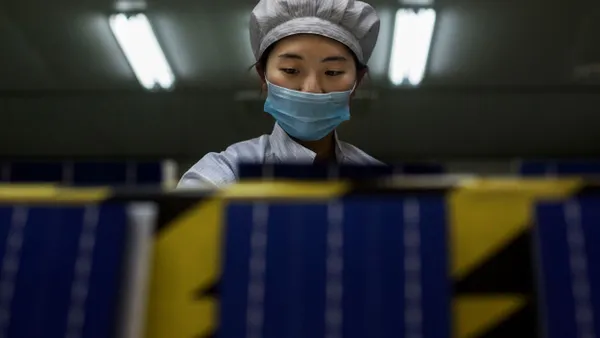The following is a viewpoint by David Carder, managing director at leadership and strategy acceleration firm Kotter.
The U.S. energy and utility industry is seeing significant growth and transformation. These aspirations to transform, however, are not without challenges.
From repairing and replacing decades-old infrastructure, to innovating new ways of providing clean energy, to updating aging technology and operating systems, the utility industry is facing a powerful set of circumstances that all require time and attention. What's more, the risk that comes with business transformation in the electric utility sector is high — critical errors can have a significant impact on the safety of employees and the public.
The question then becomes: What change should we focus on first? And, how can we, as energy and utility leaders, transform our businesses, when the stakes are so high?
Iterative over waterfall
Many components of energy and utility business transformation are interrelated — make one small change and leaders will see a ripple effect throughout the entire company. This has historically led most utility companies to take a waterfall approach to technology-based transformations — an approach where, simply put, large-scale software and technology releases are made after many months or years of preparation. When the system "goes live," in a way, it feels like leaders hold their breath and hope all of the diligence will pay off. Many times, the level of risk in these large releases can create significant implementation challenges.
This mindset can not only be less effective in driving smooth, sustainable change, it can also create risks in a context where public and employee safety are paramount.
A large multi-national utility provider discovered this first-hand when they attempted a technology transformation a few years ago. A waterfall approach to change had buy-in from senior management but failed to engage teams on the ground responsible for using the new technology day-to-day, who saw the new ways of working as risky and complicated. Usage of the new technology stalled and soon fizzled out, as users defaulted to "tried and true" methods.
This is where an iterative, or Agile, approach comes in — one that develops software and rolls out change in ways that allow the organization, leaders and employees the ability to test and learn as new releases are introduced gradually, over an extended period of time.
When this same utility adopted a more iterative approach to the second phase of their technology transition, they approached the change based on Agile principles. A small team of engaged employees on the front lines demonstrated the effectiveness of new technologies, proving that new systems and processes were just as reliable — and in fact much quicker and simpler than older methods. The new software quickly gained enthusiastic support among staff at all levels of the business and paved the way for additional software improvement projects, while building staff confidence in overall transformation efforts.
Utility leaders can take note of this approach to transformations in high-risk settings — and use it to implement their own business transformations.
Climbing the ladder
Change doesn't happen overnight. And if it does, it likely won't last long.
When introducing a large-scale transformation, it is essential for each component to be introduced slowly. We call this "climbing the ladder."
Utility leaders should not be intimidated by the scope or scale of each transformation. Rather, they should focus on harnessing the power of an iterative approach to turn a large-scale software transformation on its head — shifting and improving the business throughout a three-, four- or even five-year program. In taking an Agile approach to guiding these kinds of transformations, ask the question: "Where can we start small to mitigate risks, learn lessons, test approaches and build momentum, before beginning to roll things out more broadly?"
The first step of the ladder is simple — choose one division, location or set of functions, to try out the new way of working. For a major national utility in Europe, for example, the first step was as simple as switching from clipboards to iPads. The team considered the conditions where a small-scale change in their collections process could be set up for success and demonstrate significant short-term impact that would serve as a proof-point for large-scale systemic transformation. In pursuing such an initial step, it's important to consider need, leader support, representation of the broader organization, local culture and other factors.
As this utility did, leaders can use this carefully selected first release to troubleshoot, test and learn — helping identify where challenges arise, where disconnects occur and where potential discomfort could lurk within the proposed change. These test groups can arm leaders with the insights needed to roll out change to the broader organization — in a way that minimizes disruption and optimizes customer satisfaction.
As leaders test and learn, they will find themselves climbing the transformation ladder by adding more variables to the equation — whether it be more employees, more divisions or more facets of the desired change.
Soliciting ongoing feedback from those involved in the transformation is critical — both internally, among employees across title levels, and externally, among customers. These insights can help leaders take off the blinders, to see where potential glitches could lie and how the company can mitigate catastrophes before they occur.
Harness the power of "mini" revolutions
With complex change, leaders often overlook one, critical component to making change successful: the human brain.
As humans, we're hard-wired to avoid change — we take the same route to work, frequent the same deli for our turkey sandwich at lunch and sit in the same spot of the room during the staff meeting.
In a way, each change you implement in the broader company is a "mini" revolution within the mind of every person involved. You are taking that employee out of his or her comfort zone and reinventing how he or she works. Understanding this, and how the human brain responds to change, is critical to tapping into employees across the company and encouraging your people to embrace and drive the transformation.
How can leaders completely shift how employees work, think and understand their jobs? Again — we come back to that iterative approach. Only, this time, we apply to how people think.
Slowly introduce employees to change, to work together with human nature. Rather than the "big bang" (changing everything, all at once, about an employee's role), focus on small, short-term changes — and celebrate every single "win." If ten employees have successful customer interactions with an iPad in hand, instead of a binder, celebrate that success — and ask questions like: "What worked?", "What didn't?", "What made you uncomfortable?", "What could we do more to support you?"
For the European national utility referenced earlier, hundreds of personnel on the ground needed to make the switch to new technology, from the old manual paper process. Adoption was difficult at first, and a group of 2-4 people came up with a plan. They formed an inhouse "tech support" team to assist the people in the field when they had technology issues using the new system. They became known as "the angels". There were only a few angels to start, but then as success stories spread, not only did adoption of the new technology spread but so did people volunteering to be angels. What started with a few people ended up with hundreds of people now using the new technology and many more providing support from the office.
The longer utility leaders put off the need for transformation, the longer they continue to work with aging infrastructure or outdated operating systems — the more urgent and imperative the need for change becomes.
Ultimately, it is the end-user — not just the business or its employees—who will benefit from the collective power of each small change driven by utility leaders. From updated infrastructure to advanced technology solutions, leaders will be able to create high-touch, customer-centric experiences and, in turn, foster customer loyalty, while continuing to drive the imperative of employee and public safety.





















